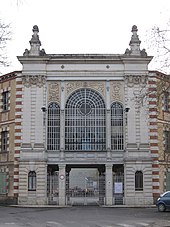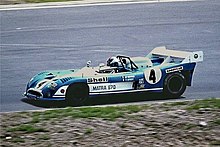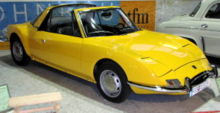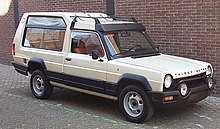Matra
| Matra
|
|
|---|---|
| legal form | Corporation |
| founding | 1941 |
| resolution | 2003 |
| Seat | France |
M écanique A vion TRA ction, or Matra for short , was a French company founded in 1941 during the German occupation with a wide range of activities, initially in the areas of aircraft and armaments construction as well as plastics processing .
Corporate policy
Jean-Luc Lagardère bought massive companies. This created a very diverse field of activity for Matra. Today a part of this company (after the merger of Aérospatiale and Matra Haute Technologie to Aerospatiale-Matra) and Matra Marconi Space operates under the name Groupe Lagardère .
Since 2004, Matra has been part of what was then EADS ( European Aeronautic Defense and Space Company ), today's Airbus Group , in which the Lagardère Group holds a 15 percent stake.
Vehicle manufacturing
History of vehicle manufacturing

In 1964, Matra took over the automaker Automobiles René Bonnet . This company had two pillars: the manufacture and use of racing cars and the small-series production of sports cars. Matra acquired the company primarily as an image bearer so that the brand name was not only associated with armaments. Even after the takeover, the direction of the company, now known as Matra Automobile , remained unchanged. Initially the brand name was Matra-Bonnet , from 1965 Matra .
The first turning point followed around 1970, when Matra Automobile handed over sales to the French subsidiary Simca of the American car giant Chrysler . From now on, the vehicles were sold under the brand name Matra-Chrysler-Simca . Even under Chrysler, racing and series production were initially operated in parallel, with the focus shifting more and more towards series production over the years. From the mid-1970s, the model range was expanded to include the Matra-Simca Rancho recreational vehicle, a (too) early forerunner of today's SUVs. At the same time, racing activities were completely stopped.
The next turning point occurred in the summer of 1978. Chrysler was economically badly hit and sold all of its European activities to the French PSA group . However, since PSA had no interest in Matra, the company was reintegrated into the old Matra group. In addition, Peugeot replaced the brand name Simca with Talbot , whereby the Matra models were sold as Talbot-Matra in the following years.
At the beginning of 1984 the cooperation with PSA / Talbot was ended. From then until the end of automobile production, Matra worked in partnership with Renault. This cooperation ended when Matra Automotive went bankrupt in February 2003. Production was discontinued and the production facilities were dismantled. Today only the development department of Matra Automotive exists, which was taken over by Pininfarina .
Production vehicles from Matra
The last sports car model presented by René Bonnet , called Djet , was initially produced and sold under the brand name Matra. In 1967 the Djet was replaced by the Matra 530 , which was named after a rocket from the company's armaments division. The Matra 530 was a four-seater mid-engine - sports car with Ford V4 -Motor, the same as its predecessor was wearing a plastic body over his steel chassis - characterizes a design which all later Matra models. Just like its predecessor, only a few hundred copies of this model were made each year.
Matra-Simca Bagheera
After the takeover by Chrysler, this model had to be replaced as soon as possible due to the Ford technology used. At the end of 1973, a new model was presented, the technology of which now came from the European Chrysler subsidiary Simca: The Matra-Simca Bagheera , the name with reference to the name of the panther Bagheera in the film Jungle Book .
This model was characterized by three seats arranged side by side - a design that was also retained in the successor model Murena , which appeared in September 1980 . The production capacity was continuously expanded, the production was already several thousand vehicles per year.
Simca-Matra Rancho and Talbot-Matra Murena
In March 1977 a second series was presented with the Rancho. It was sold as a recreational vehicle from mid-1977 to summer 1979 as Simca-Matra Rancho by the car manufacturer Simca and from summer 1979 to late 1983 as Talbot-Matra Rancho by Talbot .
The Rancho was a high roof combination based on the Simca 1100 pick-up. Due to its off-road vehicle optics, it can be counted as a pioneer of today's so popular SUV . As is typical for Matra, the body - at least in the rear half - was made of plastic parts. After a successful start, its sales figures, as well as those of the Bagheera, soon declined, as both vehicles soon had a bad reputation due to their workmanship and poor rust protection.
Matra took this as an opportunity to completely galvanize the steel chassis of the Coupé Talbot-Matra Murena, which appeared in late summer 1980 . This galvanizing was carried out by hot-dip galvanizing , in which several kilograms of zinc were deposited on each chassis and thus effectively protected it from rust.
Nevertheless, the Murena was far less successful than its predecessor, as buyers exercised restraint after their experiences with the predecessor. Production ended in January 1984 after just under four years.
Renault Espace
Between 1978 and 1982, Matra developed Europe's first MPV, or Van for short, and brought it to production readiness in March 1984 together with the manufacturer Renault as Espace (Eng .: space).
The vehicle was originally intended to be the successor to the Talbot Matra Rancho, which was discontinued at the end of 1983. PSA saw no market opportunities for the model and the continued existence of the Talbot brand was uncertain. Therefore Renault took over the almost finished van.
Initially, the marketability for this type of vehicle was often questioned. In retrospect, however, the Espace became a commercial success, for Renault as well as for Matra.
The Espace was manufactured by Matra until shortly before the fourth Espace generation appeared in October 2002.
Renault Avantime
From November 2001, Matra began producing a variant developed in-house on the third-generation Espace platform, the Renault Avantime . It impressed with its innovative design concept and is still the only "van coupé" ever produced. The high sales price of the elaborate construction and the low prestige of the Renault brand generated only small sales figures, so that production incurred high losses. After only 8,545 copies, the production of the Avantime was stopped and the automobile plant closed in February 2003.
Timeline
| Illustrated timeline of Matra Automobile vehicles | |||||||||||||||||||||||||||||||||||||||||||||
|---|---|---|---|---|---|---|---|---|---|---|---|---|---|---|---|---|---|---|---|---|---|---|---|---|---|---|---|---|---|---|---|---|---|---|---|---|---|---|---|---|---|---|---|---|---|
| Cooperations | Chrysler (Matra-Simca) | PSA (Talbot Matra) | |||||||||||||||||||||||||||||||||||||||||||
| Renault | |||||||||||||||||||||||||||||||||||||||||||||
| Brands | 60s | 70s | 80s | 90s | 2000s | ||||||||||||||||||||||||||||||||||||||||
| 0 | 1 | 2 | 3 | 4th | 5 | 6th | 7th | 8th | 9 | 0 | 1 | 2 | 3 | 4th | 5 | 6th | 7th | 8th | 9 | 0 | 1 | 2 | 3 | 4th | 5 | 6th | 7th | 8th | 9 | 0 | 1 | 2 | 3 | 4th | 5 | 6th | 7th | 8th | 9 | 0 | 1 | 2 | 3 | 4th | |
|
|
... |
 Djet |
 530 |
||||||||||||||||||||||||||||||||||||||||||
| MATRA SIMCA / TALBOT-MATRA |
 Bagheera |
 Murena |
|||||||||||||||||||||||||||||||||||||||||||
 Rancho |
|||||||||||||||||||||||||||||||||||||||||||||
|
|
 Espace I |
 Espace II |
 Espace III |
||||||||||||||||||||||||||||||||||||||||||
 Avantime |
|||||||||||||||||||||||||||||||||||||||||||||
Temporary end and almost a new beginning
The massive sales problems combined with the discontinuation of important system suppliers forced Matra to close the vehicle plant in Romorantin-Lanthenay on February 27, 2003 .
In Romorantin-Lanthenay there is also the Matra Museum. This facility, which is still well maintained, offers its visitors an overview of the entire range of racing and road vehicles that were produced there.
Matra's automotive division has been part of the Italian bodywork manufacturer Pininfarina since 2004 . After a radical restructuring of the company that was associated with deep cuts, which only left the development department, a newly formed division is now developing environmentally friendly vehicles for local transport under the name Matra Manufacturing & Services (Matra MS) in Elancourt. In the first phase after the quasi-new beginning, i.e. in the years from 2004, the company concentrated mainly on electric two-wheelers. The company also supplies the drive for the Bluecar electric car , which was jointly developed by Pininfarina and Bolloré and has been in production since 2011.
Matra in motorsport

Since 1965, Matra and its subsidiary Matra Sports have been involved in national and international automobile sports. Matra Sports designed and built its own racing cars and engines that were used in various national and international motorsport classes. In most of the classes, Matra had its own factory team; In some cases, other teams were also supplied with chassis or engines. Matra was particularly successful in Formula 1 and endurance races. As the chassis supplier to the British Tyrrell team , Matra won the 1969 Formula 1 drivers 'and constructors' championships. In endurance racing, Matra won the Le Mans 24-hour race three times in a row .
Transport systems
Matra developed and produced the Véhicule automatique léger (VAL) system in the 1970s.
From 1973 to 1987 Matra developed and tested the Aramis local transport system - a PRT system that was created in parallel with the VAL. However, the Aramis passenger cabins were significantly smaller than those of the VAL. They were originally designed for only four people. Due to technical deficiencies and a lack of customers, there were only test tracks that were later closed. They were in Orly near Paris and on Paris Boulevard Victor.
In 1996, Matra Transport International SAS (MTI) became a joint venture between Lagardere Groupe SCA and Siemens. In 1998 Siemens increased its stake to 95 percent, in 2001 Siemens also took over the remaining shares, at that time ten percent. On November 5 of the same year, MTI was renamed Siemens Transportation Systems (STS).
computer
Matra produced a home computer, the Matra Alice .
Telecommunication solutions
In 1986, Matra entered the telecommunications solutions business. At that time, telecommunications solutions were developed under the brand name Matra Communication SA and first marketed in France and later internationally.
There were the following business areas:
- End devices (telephones, fax machines, cordless telephones, Minitel)
- Telecommunication systems (PABX) for companies with the MATRACOM MC6500 product line
- Safety radio networks (PMR = professional mobile radio) with the TETRAPOL product line
- Mobile communication networks (GSM)
Matra Communication SA became the second largest provider of telecommunications solutions in France with a market share of over 36 percent. The systems were used primarily by public clients.
The biggest projects were:
- for telecommunications systems the French military with over 200,000 devices
- for PMR systems the French police, fire brigade and rescue services with over 350,000 devices
- for GSM the French GSM network of France Telecom
In 1991 the joint ventures Matra Nortel Communications and Nortel Matra were founded. The Canadian telecommunications supplier Nortel only took a 21% stake and took over 51% of the shares in 1999. In Germany, the DFG (Deutsche Fernsprecher Gesellschaft Marburg) and AEG Mobile Communication GmbH (AMC) were taken over.
In 2002 the division was taken over by the European space and defense group EADS and distributed under the name EADS Telecom.
In January 2005, the civil telecommunications business was sold to the global telecommunications group Aastra Technologies Limited . However, the business for military telecommunications and the supply of government agencies remained unaffected by this sale.
armor
The development of the Mistral anti-aircraft guided missiles as well as the TDA F.1 / F.4 and the Matra 155 rocket tube launcher were in the hands of Matra in 1977.
Space travel
Matra was the prime contractor for the ESRO TD-1A satellite and a member of the MESH space consortium consisting of:
- M atra
- E RNO
- S aab .
- H awker Siddeley Dynamics (HSD).
In the 1970s, Matra was a subcontractor to ERNO, responsible for developing the data processing system for Spacelab.
In 2000, Matra Marconi Space merged with DaimlerChrysler Aerospace to form Astrium GmbH.
literature
- Dominique Pagneux : Matra de route. Boulogne-Billancourt 2003, ISBN 2-7268-8603-5 .
Web links
- Matra Museum ( Memento from September 15, 2007 in the Internet Archive ) (French)
Individual evidence
- ^ Bruno Latour: Aramis or the Love of Technology. Harvard University Press, Cambridge (Mass.), London (Engl.) 1996, ISBN 0-674-04323-5 .
| Timeline of the Clement Talbot / Automobiles Talbot / Talbot (PSA) / Chrysler Europe / Simca / Rootes / Matra models from 1945 to 1986 | ||||||||||||||||||||||||||||||||||||||||||||||||||||||||||||||
|---|---|---|---|---|---|---|---|---|---|---|---|---|---|---|---|---|---|---|---|---|---|---|---|---|---|---|---|---|---|---|---|---|---|---|---|---|---|---|---|---|---|---|---|---|---|---|---|---|---|---|---|---|---|---|---|---|---|---|---|---|---|---|
| Type | SIMCA until 1957 , Rootes Group independent until 1967 |
Entry of Chrysler , formation of Chrysler Europe | Part of PSA (Peugeot) from the end of 1978 | |||||||||||||||||||||||||||||||||||||||||||||||||||||||||||
| 40s | 50s | 60s | 70s | 80s | ||||||||||||||||||||||||||||||||||||||||||||||||||||||||||
| 5 | 6th | 7th | 8th | 9 | 0 | 1 | 2 | 3 | 4th | 5 | 6th | 7th | 8th | 9 | 0 | 1 | 2 | 3 | 4th | 5 | 6th | 7th | 8th | 9 | 0 | 1 | 2 | 3 | 4th | 5 | 6th | 7th | 8th | 9 | 0 | 1 | 2 | 3 | 4th | 5 | 6th | 7th | 8th | 9 | ||||||||||||||||||
| Small car | Imp / Imp Californian / Husky 4 | Sunbeam 5 | Sunbeam 5 | |||||||||||||||||||||||||||||||||||||||||||||||||||||||||||
| Chamois 4 | ||||||||||||||||||||||||||||||||||||||||||||||||||||||||||||||
| Stiletto 4 | ||||||||||||||||||||||||||||||||||||||||||||||||||||||||||||||
| ... | 5/6 | 1000/900/1005/1006 | Samba 8 | |||||||||||||||||||||||||||||||||||||||||||||||||||||||||||
| Compact class | Avenger 5 | Avenger 5 | Avenger 5 | |||||||||||||||||||||||||||||||||||||||||||||||||||||||||||
| ... | 8 / 8/1200 | 1100 7 | 1100 7 | |||||||||||||||||||||||||||||||||||||||||||||||||||||||||||
| Horizon 7 | Horizon 7 | Horizon 7 | Arizona | |||||||||||||||||||||||||||||||||||||||||||||||||||||||||||
| Middle class | ... Minx (Mk I-Mk VII) / Husky Mk I | Minx / Husky (SI-SIII) 1 | Minx / Super Minx / Husky 2 | New Minx / Hunter 3 | Hunter 3 | Hunter 3 | ||||||||||||||||||||||||||||||||||||||||||||||||||||||||
| SM 1500 | Hunter | Gazelle 1 | Gazelle / Vogue 2 | New Gazelle / Vogue 3 | ||||||||||||||||||||||||||||||||||||||||||||||||||||||||||
| ... Ten / 2L | 80 / 90 (MkI) | 90 (MkII) | Mk III | Rapier (SI – V) 1 | New Rapier / Rapier H120 3 | |||||||||||||||||||||||||||||||||||||||||||||||||||||||||
| Scepter I + II 2 | New Scepter 3 | Solara 6 | Solara (GB: Minx / Rapier) 6 | |||||||||||||||||||||||||||||||||||||||||||||||||||||||||||
| Hawk (Mk I-III) | Hawk (Mk IV – VI) | Hawk (SI-IV) | Alpine 6 | Alpine 6 | Minx / Rapier 6 | |||||||||||||||||||||||||||||||||||||||||||||||||||||||||
| 9 Aronde | Aronde | Aronde (P60) | 1300/1500 | 1301/1501 | 1301/1501 | 1307/1308 6 | 1510 6 | 1510 6 | ||||||||||||||||||||||||||||||||||||||||||||||||||||||
| upper middle class | ... Snipe / Super Snipe (I-III) | Super Snipe (VI) | Super Snipe (SI – V) | |||||||||||||||||||||||||||||||||||||||||||||||||||||||||||
| infant | Ariane | 160/180 | 160/180 / 2L | 1610 / 2L | 1610 / 2L | Tagora 9 | ||||||||||||||||||||||||||||||||||||||||||||||||||||||||
| Upper class | Pullman / Imperial (Mk I IV) | Imperial | ||||||||||||||||||||||||||||||||||||||||||||||||||||||||||||
| Record | Vedette | |||||||||||||||||||||||||||||||||||||||||||||||||||||||||||||
| Coupé / convertible | Imp Sport 4 | |||||||||||||||||||||||||||||||||||||||||||||||||||||||||||||
| 1000 coupe | 1200 p | |||||||||||||||||||||||||||||||||||||||||||||||||||||||||||||
| Alpine MkI / III | Alpine SI – IV / Tiger | New Alpine 3 | ||||||||||||||||||||||||||||||||||||||||||||||||||||||||||||
| Comète | America | |||||||||||||||||||||||||||||||||||||||||||||||||||||||||||||
| Sports car | T26 Grand Sport / Saoutchik | Sports | Djet | jet | 530 | Bagheera | Bagheera | Murena | ||||||||||||||||||||||||||||||||||||||||||||||||||||||
| SUV | Rancho | Rancho | ||||||||||||||||||||||||||||||||||||||||||||||||||||||||||||
| Box van | 1100 VF2 / VF3 | City truck | City truck | |||||||||||||||||||||||||||||||||||||||||||||||||||||||||||
1 common platform of the Rootes group based on the Hillman Minx 1956 |
||||||||||||||||||||||||||||||||||||||||||||||||||||||||||||||








